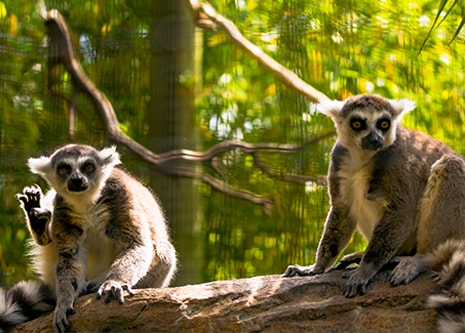
- VisitSupport Happy HollowDONATE TODAYExploreSupport Happy HollowDONATE TODAYLearnSupport Happy HollowDONATE TODAYSupportToday’s Hours: CLOSEDZoo in the Hollow
Crested wood partridge

Scientific name: Rollulus rouloul
Family: Phasianidae
Order: Galliformes
Class: Aves
Range: Southeast Asia
Habitat: Subtropical and tropical forest
Lifespan: UnknownWhat do they look like?
Crested partridges, like other game birds, are rotund with small heads and short rounded wings. They are a small dimorphic (males look different from females) species, despite both having red patches of skin around their eyes, red legs and hind toes. Males have feathers that are dark metallic green in color with dark bluish-purple or black tint, and a white spot and tall red crest of feathers on their foreheads, which gives the species its name. Females are slightly smaller than males and are pea or olive green with brown wings. Female crested partridges have grey heads with some longer feathers, but no red crest or white spot.How do they behave?
Crested partridges are typically found alone or in pairs, but these birds may live cooperatively in groups of up to fifteen birds. They are predominately diurnal (awake during the daytime), spending most of their day foraging. Crested partridges are ground-dwelling birds, and as a result, they are not strong long-distance fliers and therefore usually run to escape from predators. However, they can fly rapidly over short distances if necessary. At night, they typically roost on the ground or in low hanging trees, huddled in groups.What do they eat?
In the wild, crested partridges use their feet to forage for fallen fruit, seeds, and invertebrates. At Happy Hollow, they eat seeds, fruits, vegetables and specialized bird pellets.How are they born?
Crested partridges may breed year-round, depending on the availability of territory and the quality of seasonal conditions. These birds make their nests by scratching at the ground. They line or cover their nests with leaves, often creating a small tunnel. On average, they lay five to six white eggs, which are incubated for about 18 days. While unusual for most game birds, partridge chicks are fed bill-to-bill by the parents for about a week before they forage for their own food. Chicks develop quickly and resemble duller versions of their parent of the same sex. Both parents take part in caring for the young.Conservation
The crested partridge is listed as a species that is Near Threatened by the International Union for Conservation of Nature . These birds are only found in the Sundaic lowlands, which are located in Southeast Asia, including Myanmar, Malaysia and Indonesia. There is some concern regarding the status of these birds due to increased logging in Southeast Asia, which contributes directly to habitat loss for this species. Their habitat is perfect for growing trees used in the rubber or palm oil industry, and the forests are often logged to make room for these more profitable plant species. Organizations such as Burung Indonesia are collaborating with BirdLife International, the world’s largest nature conservation partnership, to work with communities to promote collaborative conservation and sustainable development. If you would like to help the crested partridge, you can pledge to only buy and use products that contain sustainable palm oil that is Roundtable on Sustainable Palm Oil (RSPO) certified. If you have a sweet tooth, you can support that habit and help save critical habitat by opting for candy that is wildlife-friendly and sustainable.
Zoo on the Hill
Located across from the Keep-Around Carousel is the Zoo on the Hill. Learn about wildlife up close during daily meet-and-greets, leap like a lemur on the playground, brush and feed the goats,, or take a peek inside Doc’s Critter Care building and the Ranch House. Double-H Ranch features a combination of animal exhibits, including giant anteaters and red ruffed lemurs, as well chickens and domesticated animals that are docile enough to touch.
See Animals
Education Ambassadors
From camps and classes to scout badges and sleepovers, Happy Hollow education programs have something for everyone! The zoo education program offers a broad range of hands-on, engaging programs and public presentations featuring education ambassador animals. These encounters are designed to connect you to wildlife and the conservation of their habitats around the world.
See AnimalsVisit Us Today
Plan an unforgettable experience at San Jose’s family-friendly park and zoo.
Learn more